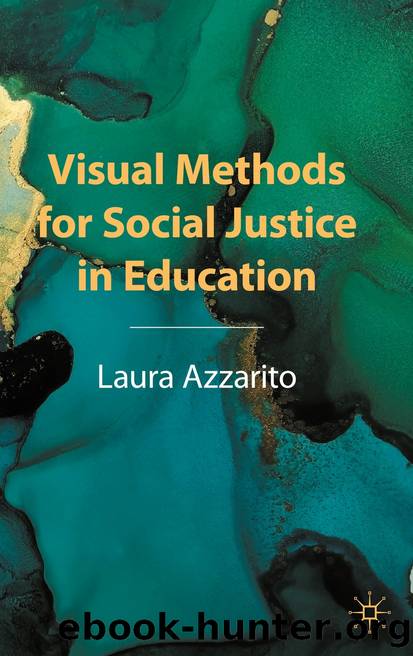Visual Methods for Social Justice in Education by Laura Azzarito

Author:Laura Azzarito
Language: eng
Format: epub
ISBN: 9783031257452
Publisher: Springer International Publishing
In line with Delgradoâs (2015) viewpoint, Mitchell et al. (2016) summarized that the photovoice method creates opportunities for marginalized populations to â1) develop strategies to reach policy-makers; 2) critically reflect on the issues; and 3) develop strategies to reach policy-makersâ (p. 244). For instance, âWe live in the shadowâ (Kaplan, 2008) photovoice study brings hidden stories to the surface, displaying a visual testimony of inner-city kidsâ experiences of their schools, neighborhoods, and family life. As a participatory arts community-based project, âinner city kids tell their storiesâ (Kaplan, 2013) in a neighborhood of high poverty and use photography to reveal the hidden and harsh realities of poverty and exclusion, reaching out to the public for critical reflection and social change.
Further, photovoice is a research methodology that emphasizes the intrinsic relationship between photo, voice, and âseeing,â opening up a wide range of empowering ways for research participants to âseeâ a problem and thus to offer alternative ways for the public to âlookâ at the issue. A âdifferentâ look at a problem can establish the need for policymakers to address the problem. For instance, using cellphilmmaking, Yang (2015) employed photovoice with young people in the context of South Africa to explore their responses to HIV-related issues, using social media as a site of public pedagogy to disseminate young peopleâs video production with policymakers and advocating for social change. The participatory video-making task resulted in a powerful tool of engagement for young people in an underserved school community and generated rich and thoughtful data. However, reflecting upon the research process, Yang (2015) cautioned researchers that young peopleâs self-generated visual data disseminated on social media requires adequate and careful provision of care and safety by adults. Especially when researchers deal with socially sensitive issues (e.g., drug abuse, HIV and AIDS, teen pregnancy) and/or with vulnerable populations, centering young people in the participatory research process calls for the researcher to work with and for young people with ethics of care. While participatory videos aim to reduce stigmatization, without cautious attention to the ways in which young people decide to represent themselves on social media, research participantsâ video production might unintentionally reproduce stereotypes. To avoid unintentional misrepresentations, putting the themes and messages that emerged from photovoiceâs research on display at public venues or exhibitions to share with community members, policymakers, and families needs careful consideration. As Fleming et al. (2009) noted, only with thoughtful curation does photovoice have the ability to capture a visual image in humanizing ways and then transform the image into a pedagogical vehicle for disseminating new information beyond the academic sphere among community members and policymakers for social change.
Community-based research can also be beneficial to other marginalized populations, such as LGBTQ youth of color, whose voices and experiences continue to be hidden, excluded, and altered by the racialized heteronormative gaze. To respond to the absence of research on the voice of LGBTQ youth of color, recently Capous-Desyllas and Mountz (2019) employed a photovoice methodology to explore the history, pathways, and life trajectories of youth before, during, and after foster care.
Download
This site does not store any files on its server. We only index and link to content provided by other sites. Please contact the content providers to delete copyright contents if any and email us, we'll remove relevant links or contents immediately.
| ASVAB | GED |
| GRE | NCLEX |
| PRAXIS | SAT |
| See more | College & High School |
| Driver's Education | Graduate School |
| Professional | Study & Test-Taking Skills |
| Study Guides & Workbooks | TOEFL & TOEIC |
| Test Flash Cards |
Super Crunchers by Ian Ayres(1135)
Series 7 Exam For Dummies by Steven M. Rice(1130)
The Strategy Paradox by Michael E. Raynor(1109)
The Back of the Napkin by Dan Roam(1081)
The Lewis Man by Peter May(973)
The Waste Land and Other Poems by T. S. Eliot(954)
Ultimate Aptitude Tests by Jim Barrett(926)
Lewis 02: The Lewis Man by Peter May(893)
Securities Industry Essentials Exam For Dummies with Online Practice by Steven M. Rice(890)
Cracking the CSET (California Subject Examinations for Teachers) by Princeton Review(877)
Series 7 Exam For Dummies by Rice Steven M(871)
Series 7 Exam for Dummies, with Online Practice Tests by Steven M. Rice(862)
Ultimate IQ Tests: 1000 Practice Test Questions to Boost Your Brainpower (Ultimate Series) by Russell Ken & Carter Philip(859)
The Official DVSA Guide to Driving the essential skills by Driver & Vehicle Standards Agency(858)
Post Office Jobs by Dennis Damp(831)
Test Your Emotional Intelligence by Philip Carter(800)
ARRL's General Q&A by ARRL(780)
A Bend in the Road by Nicholas Sparks(768)
Schaum's Outline of College Algebra by Murray Spiegel(709)
